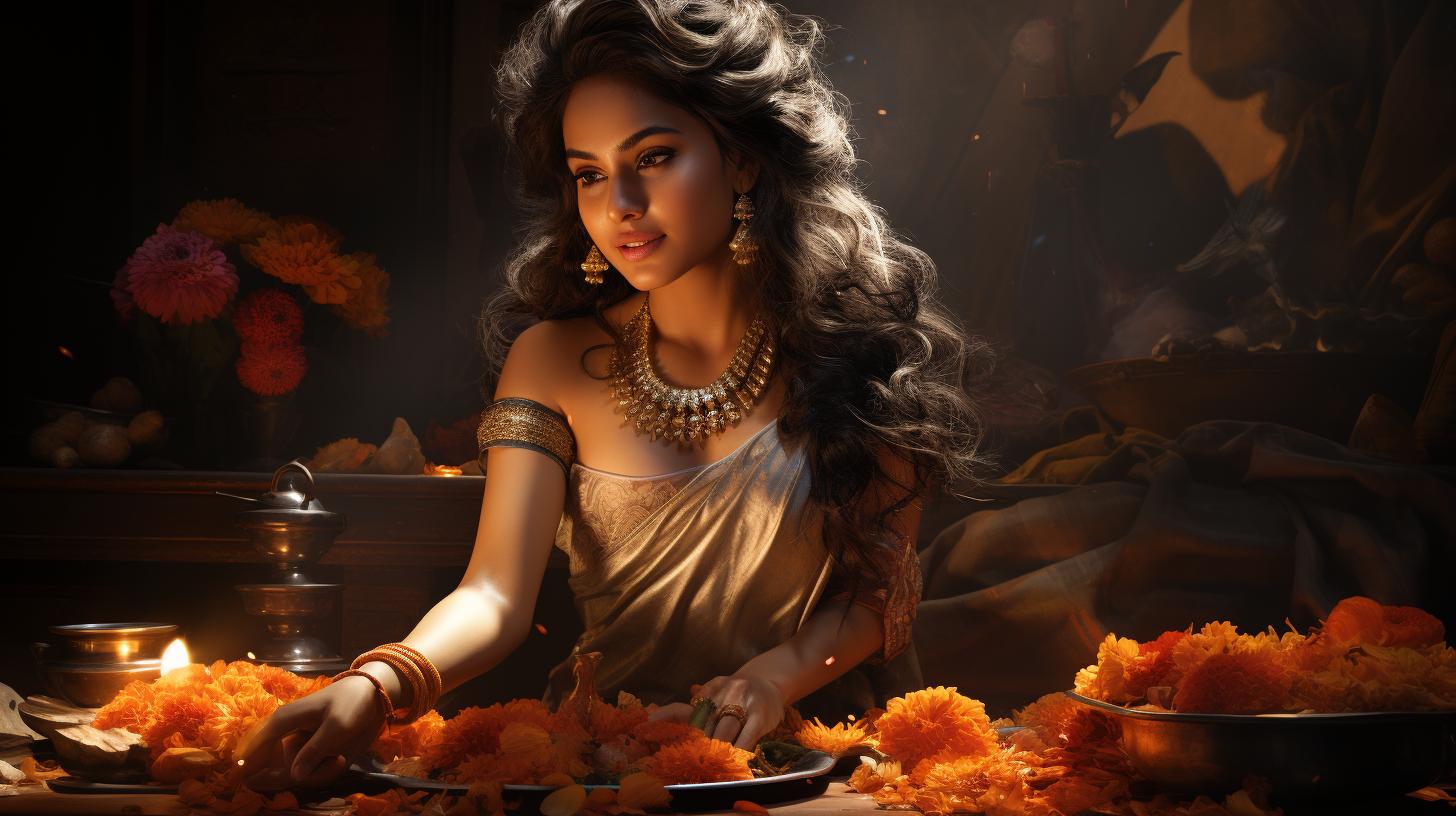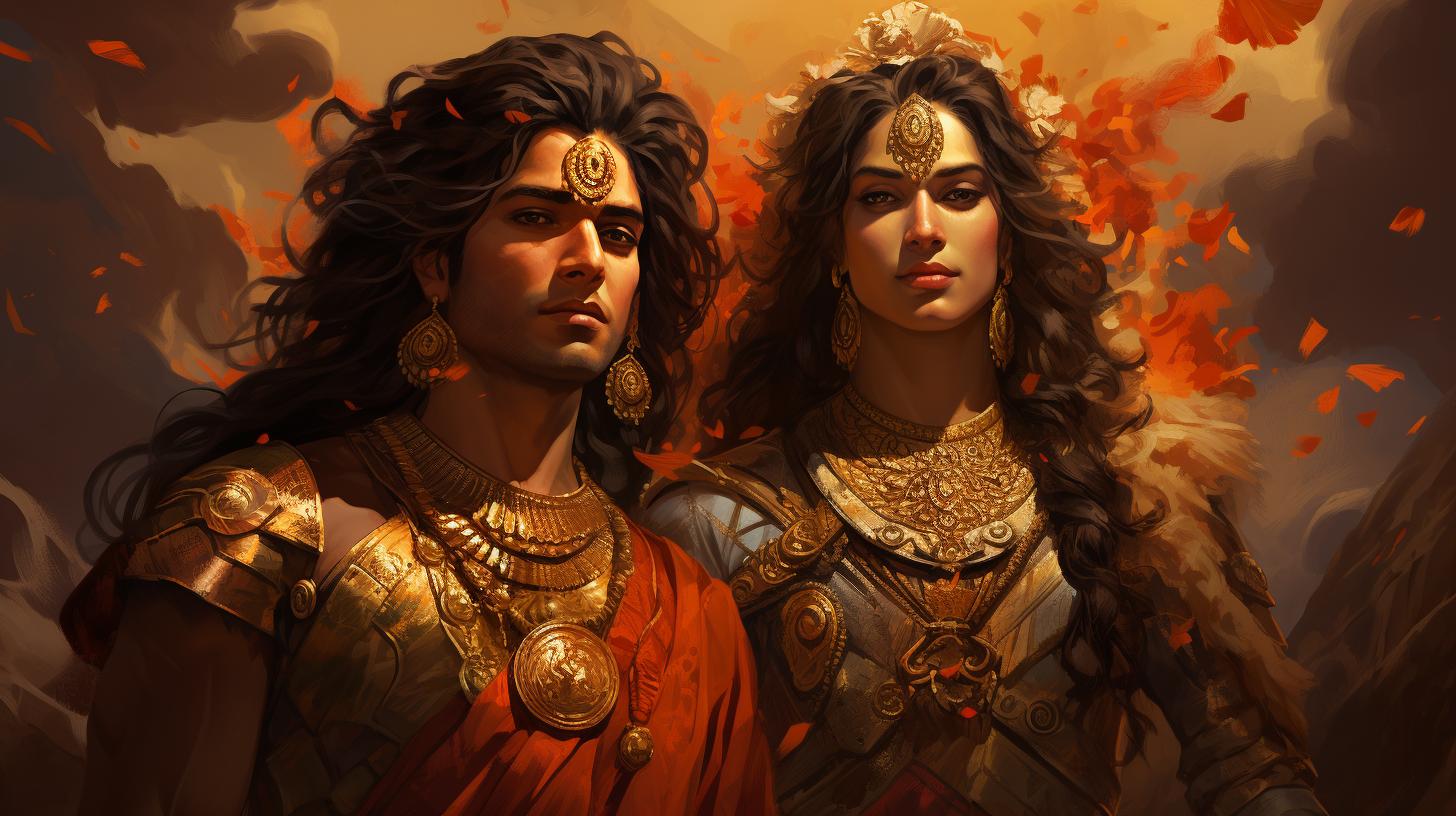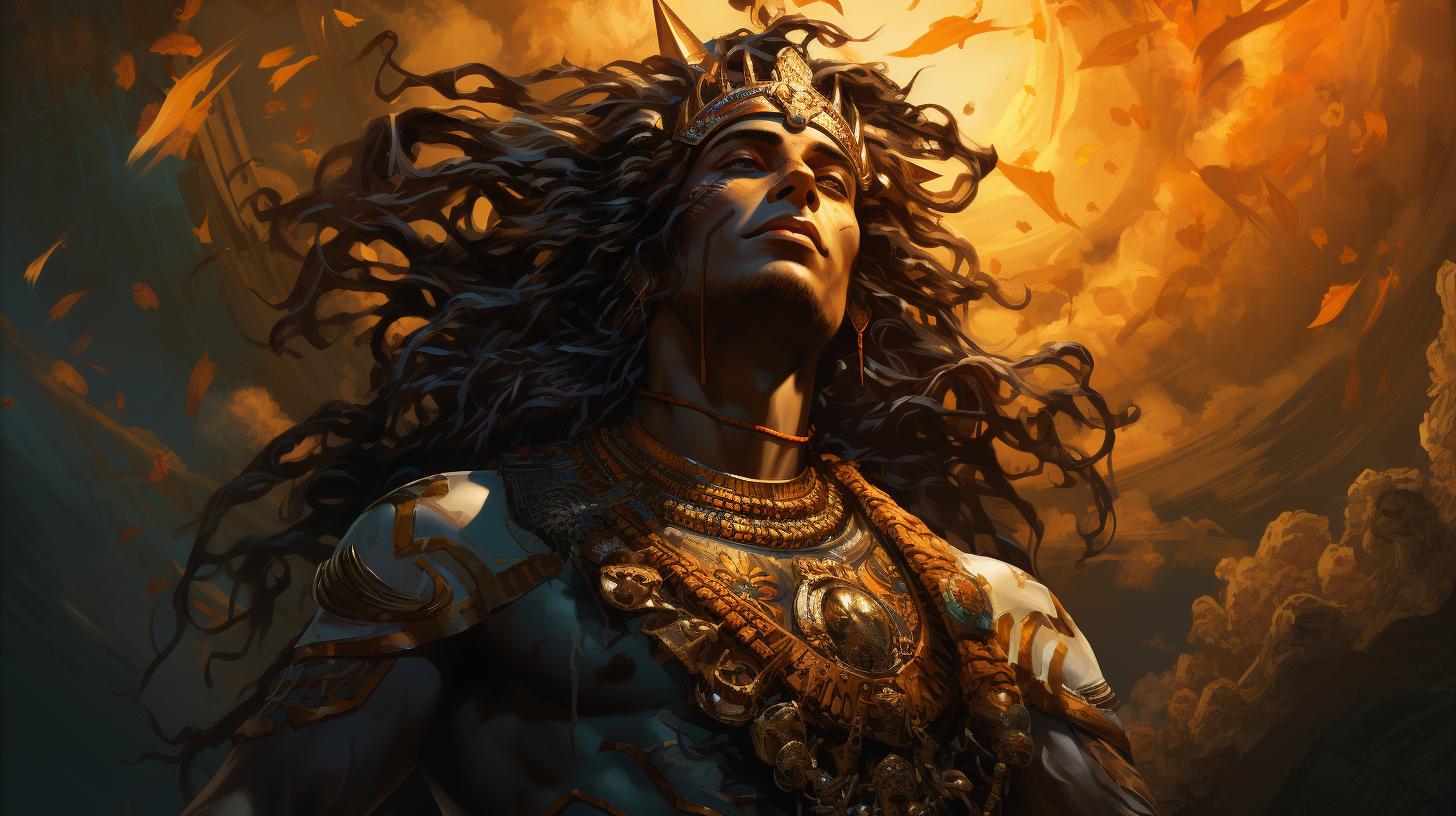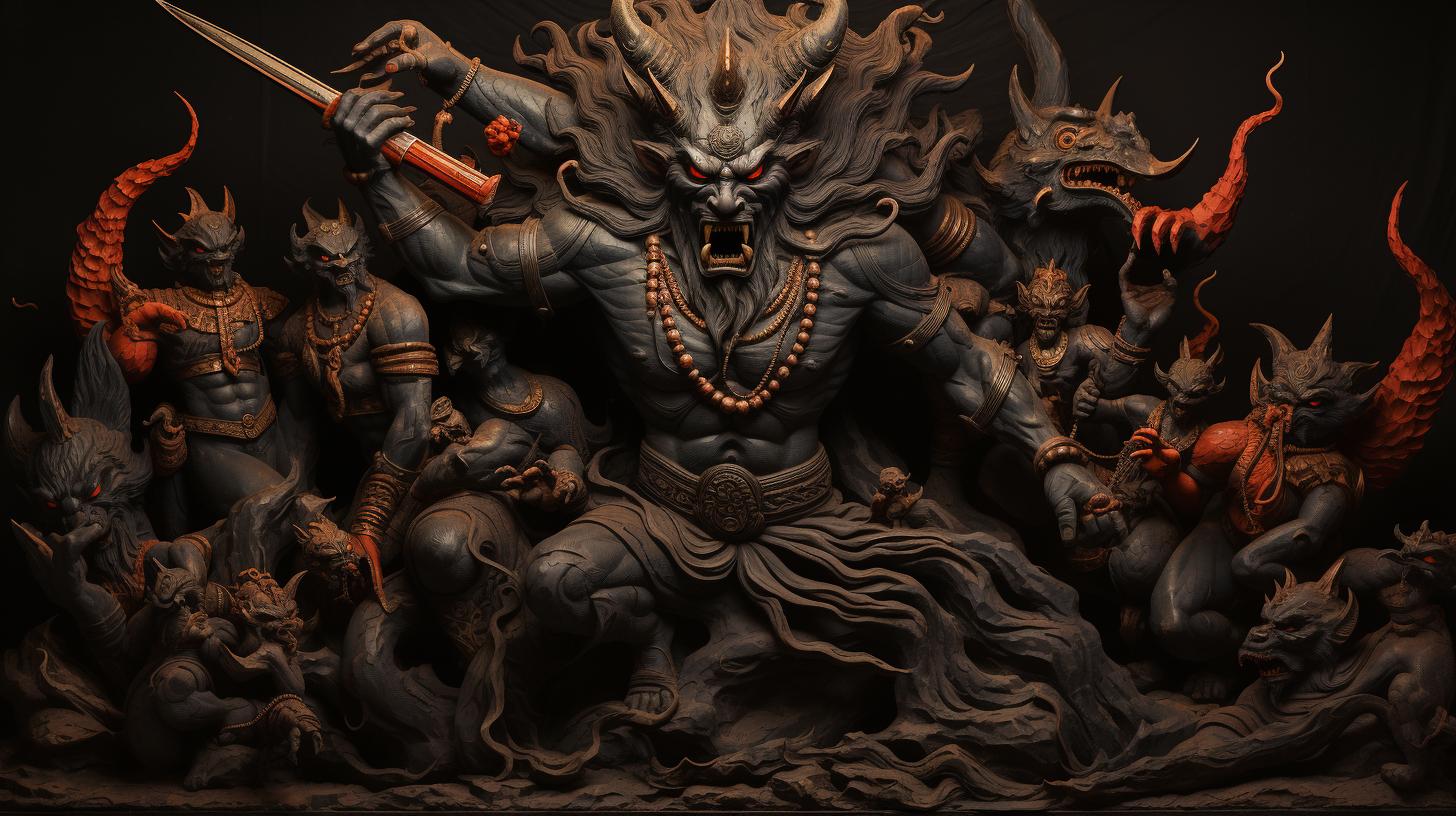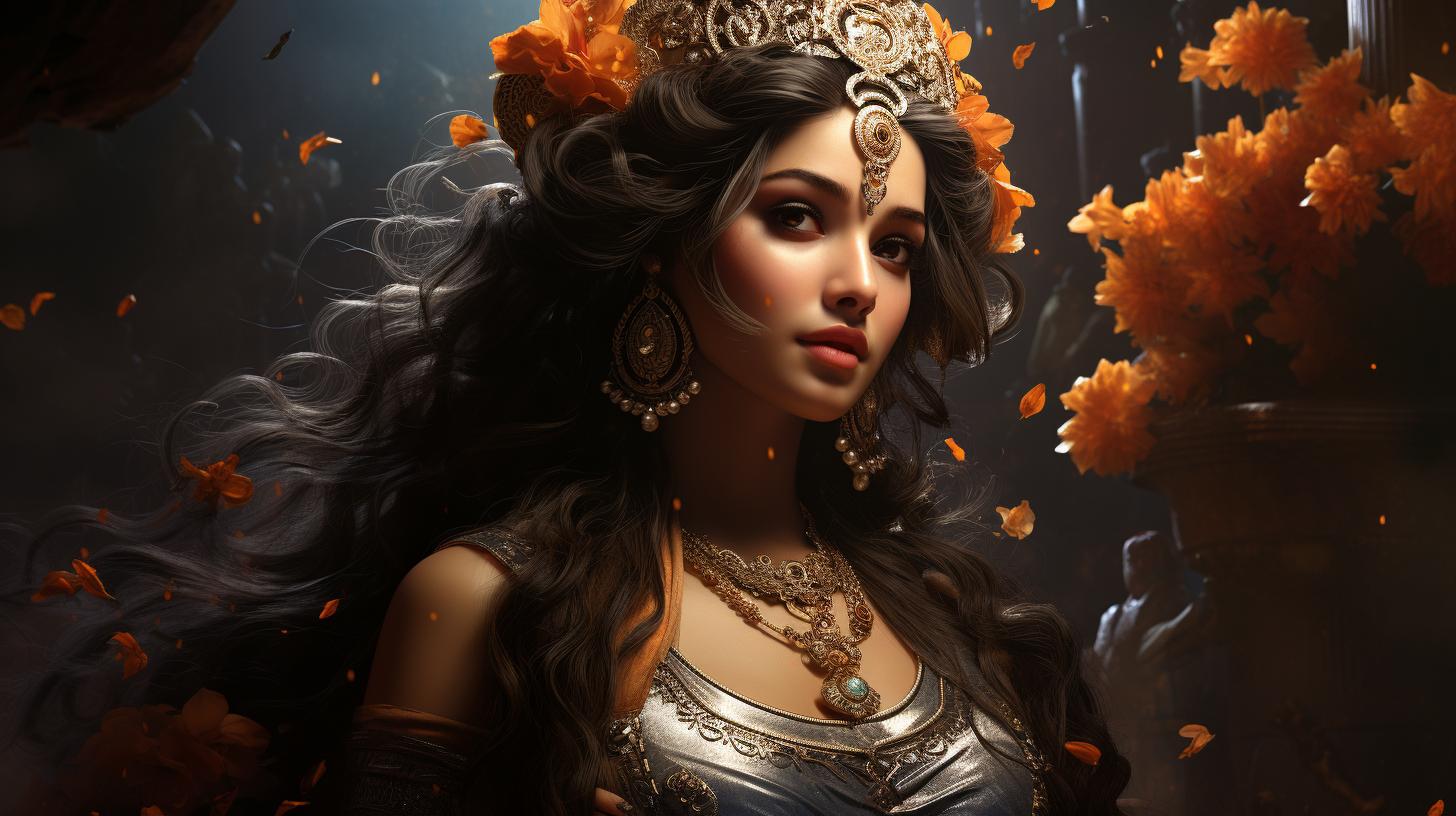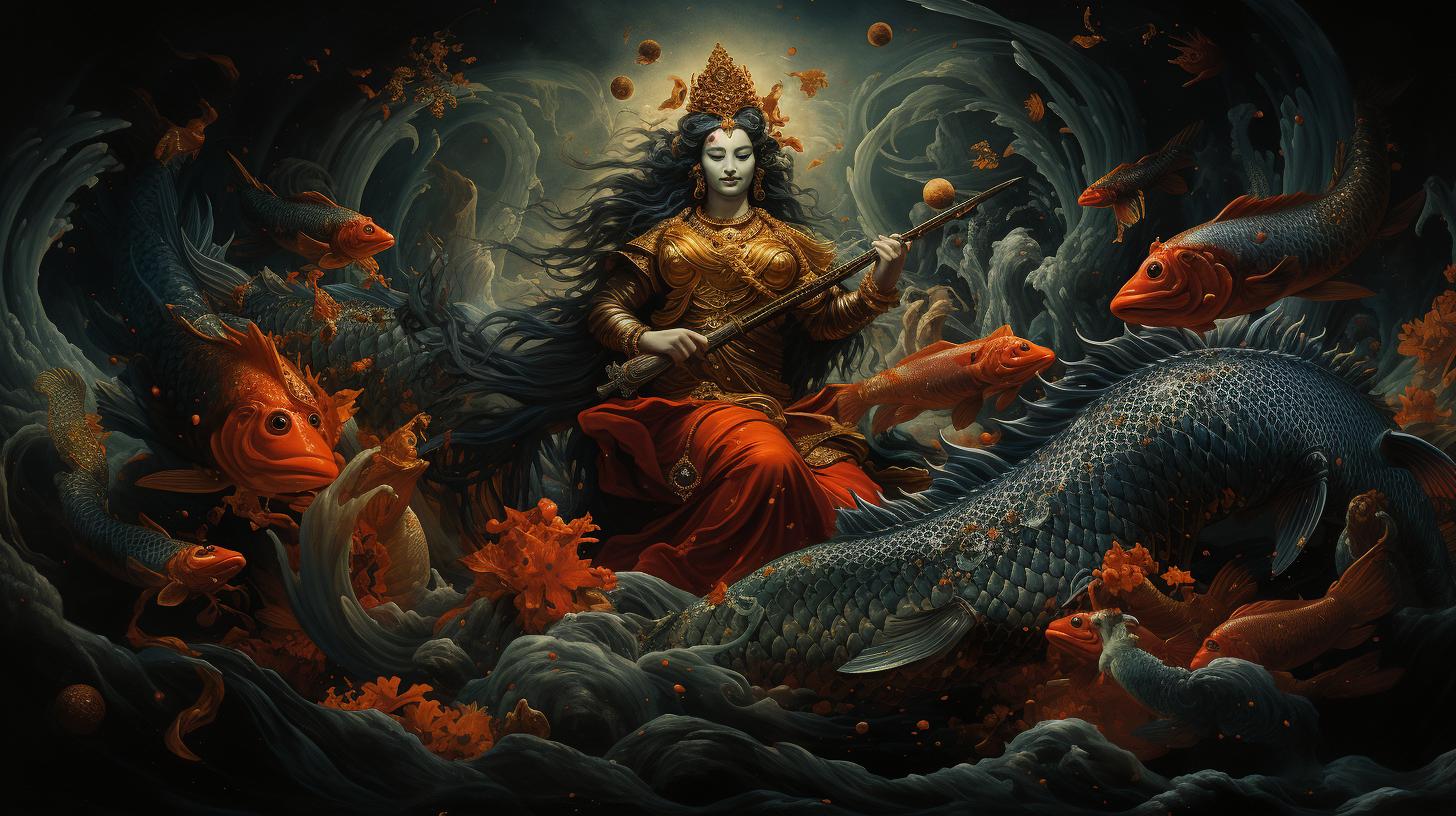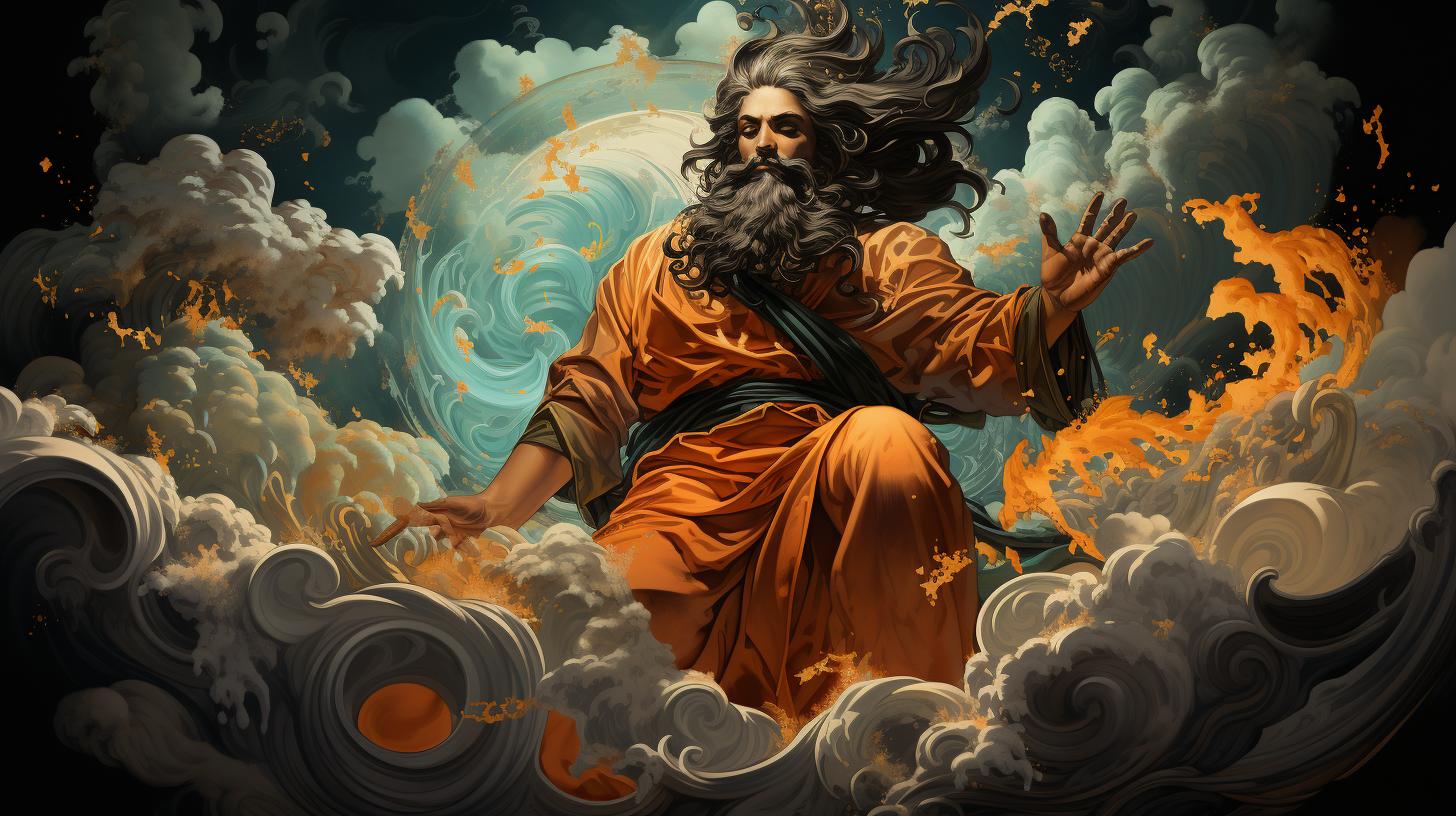Kamadeva Hindu God of Love: Unveiling the Divine Essence of Romance in Hindu Mythology
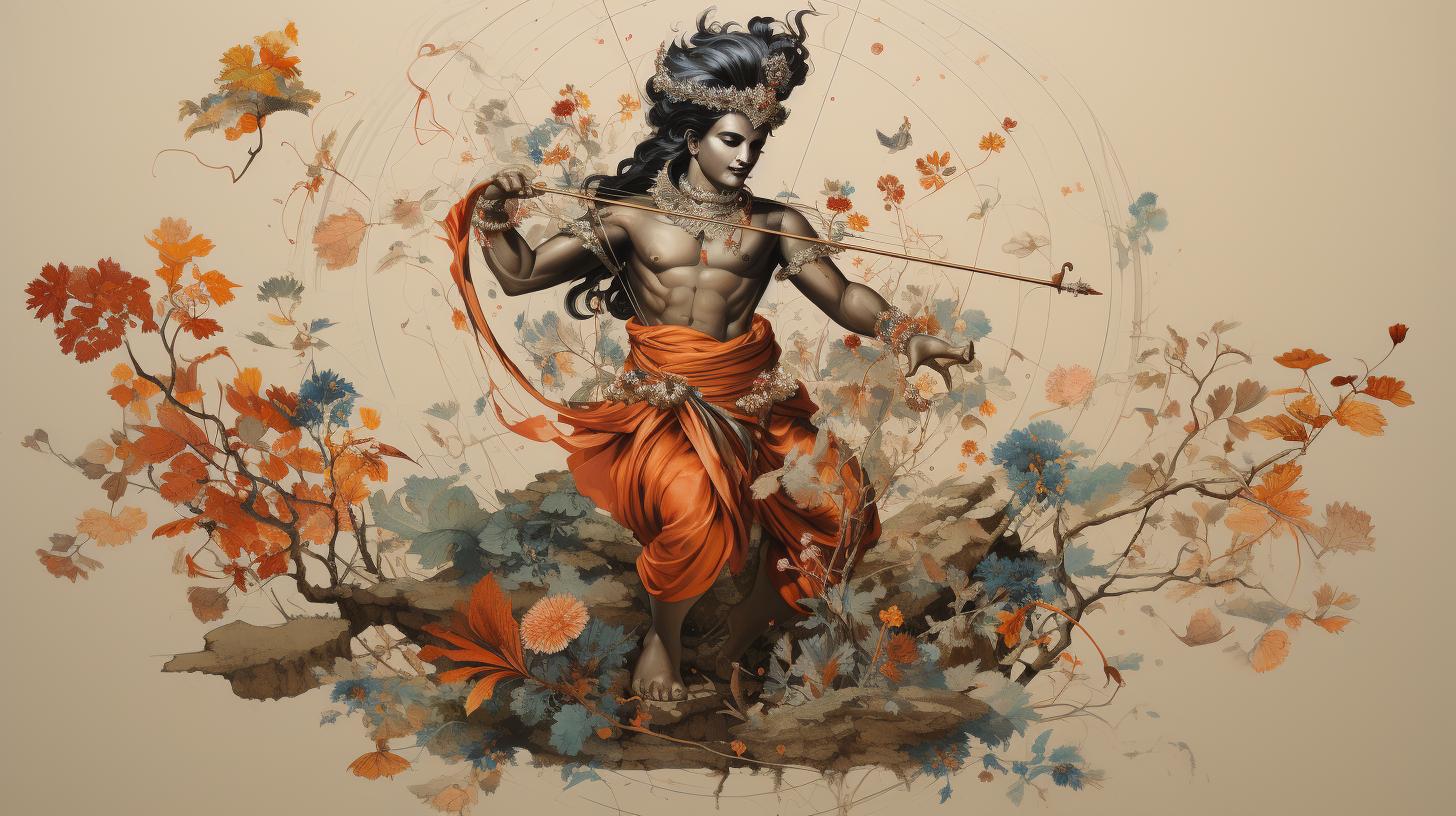
Kamadeva, the Hindu god of love, holds a significant role in mythology. From his origins as the son of Brahma and Rukmini, to his association with spreading love and desire through his flowered arrows, Kamadeva’s story captivates.
His curse by Shiva and subsequent rebirth, along with his divine relationship with Rati, adds depth to his character. Depicted in scriptures like the Rig Veda and the Atharva Veda, Kamadeva’s imagery and symbolism continue to inspire artists.
Today, Kamadeva’s influence remains prevalent, leaving a lasting mark on modern culture. Discover more about this intriguing deity and his place in Hinduism.
Kamadeva in Hindu Mythology: Origins and Role
In Hindu mythology, Kamadeva holds a significant place as the god of love. His origins can be traced back to his parentage, being the son of Brahma, the creator of the universe, and his principal wife, Rukmini.
As a youthful and charming deity, Kamadeva is often portrayed wielding a bow adorned with flowered arrows. These symbolic arrows serve as powerful instruments for spreading love and desire throughout the world.
The role of Kamadeva extends beyond mere matchmaking. He carries the creative power of the universe, responsible for the propagation of love and affection in all its forms. Kamadeva’s presence is believed to inspire passion, intimacy, and the creation of deep emotional connections among individuals.
Various versions exist regarding Kamadeva’s birth. One such account depicts him as being deliberately created by Brahma to ignite passion within the prajapatis, the progenitors of mankind. However, this act incurs the wrath of Shiva, resulting in a curse that leads to Kamadeva’s eventual burning by Shiva’s fiery gaze.
Despite this tragic fate, Brahma ensures Kamadeva’s rebirth, signifying the eternal nature of love and desire.
Kamadeva’s romantic partner is Rati, who personifies sensual pleasure. Together, they form a divine couple and are blessed with two sons, Harsha and Yashas. Their union exemplifies the balance between physical desire and emotional connection, reinforcing the multifaceted nature of love that Kamadeva represents.
The mythology surrounding Kamadeva can be found in ancient texts such as the Rig Veda and the Atharva Veda. However, it is through the stories and legends of the Puranas that Kamadeva is most widely known.
These tales narrate his exploits, trials, and even his encounter with Shiva, providing a rich tapestry of narratives that highlight the god of love’s significance in Hindu mythology.
The Family of Kamadeva: Relationships and Divine Connections
Kamadeva, the Hindu god of love, is not only known for his own divine attributes but also for his intricate family connections and relationships in Hindu mythology.
Let’s delve into the fascinating details of Kamadeva’s family and the divine bonds he shares.
Parentage and Progeny
This lineage bestows upon Kamadeva a significant position in the Hindu pantheon.
He is revered as the embodiment of the creative power responsible for spreading love throughout the world.
Kamadeva’s marital bond with Rati, the goddess representing sensual pleasure, adds depth to his character.
Together, they form a divine couple known for their influence in the realm of desire and romance. Kamadeva and Rati are blessed with two children as well — Harsha and Yashas, who further contribute to the rich tapestry of their divine lineage.
Divine Connections
While Kamadeva’s connections with his immediate family are well-known, he also shares associations with other deities in Hindu mythology. One of the noteworthy connections is his close relationship with Brahma, his father, who entrusted him with the responsibility of igniting passion and love among the prajapatis.
Additionally, Kamadeva’s role intertwines with that of Shiva, the destroyer aspect of the Hindu trinity. The story of Kamadeva’s curse, wherein Shiva burns him and later ensures his rebirth, showcases their complex relationship.
It exemplifies how even the gods themselves are subject to the cycle of birth, death, and renewal.
These divine connections and relationships demonstrate the multifaceted nature of Kamadeva’s character and the significant role he plays in various mythological narratives.
The Symbolism of Kamadeva’s Arrows: Spreading Love and Desire
Kamadeva, the Hindu god of love, is famously depicted with his iconic weapon – the bow and arrow. These arrows hold deep symbolism, representing the power of love and desire that Kamadeva wields over the universe.
Let’s delve into the symbolism behind Kamadeva’s arrows and their role in spreading love.
1. Power of Attraction: The arrows of Kamadeva are adorned with fragrant flowers, symbolizing their ability to attract and captivate.
Just as the sweet fragrance of flowers entices the senses, these arrows have the power to effortlessly draw individuals towards each other, igniting feelings of love and desire.
2. Creation of Affection: When Kamadeva shoots one of his flowered arrows at someone, it creates an immediate bond of affection.
These arrows pierce the heart, filling it with overwhelming emotions and stirring the flames of love. The arrows act as catalysts, bringing people together and fostering deep connections.
3. Awakening Passion: Kamadeva’s arrows awaken the dormant passion within individuals.
They inspire intense feelings and ignite the fire of desire, evoking a sense of longing and yearning. Just like an arrow piercing through the soul, Kamadeva’s arrows awaken the depths of one’s emotions, infusing life with passion.
4. Spreading Love: As Kamadeva shoots his arrows, love spreads like wildfire. The arrows have the power to touch multiple hearts simultaneously, transcending boundaries and crossing barriers. They carry the essence of love within them, spreading its enchanting influence far and wide.
5. Inducing Bliss: When struck by Kamadeva’s arrows, individuals experience a sense of euphoria and bliss. The arrows have the ability to bring immense joy and happiness, overwhelming the senses with the ecstasy of love.
They leave a lasting impact, filling lives with moments of pure bliss.
Kamadeva’s arrows hold immense symbolism, representing the universal force of love and desire. They possess the power to attract, create affection, awaken passion, spread love, and induce bliss in the lives of those touched by them.
Understanding the symbolism behind Kamadeva’s arrows allows us to comprehend the profound influence of love in Hindu mythology and its significance in our own lives.
The Story of Kamadeva’s Curse: Shiva’s Role and Kamadeva’s Rebirth
In Hindu mythology, the story of Kamadeva’s curse is a tale of tragic consequences and eventual rebirth.
It revolves around the interplay between Kamadeva, the god of love, and Shiva, the destroyer.
According to various scriptures, Kamadeva was bestowed with the power to ignite passion and desire in the hearts of living beings.
However, his unrivaled beauty and influence became a cause of concern for the gods. They feared that his influence could potentially disrupt their devotion and meditation.
One day, Kamadeva was tasked with a significant mission – to awaken Lord Shiva from his deep meditation.
Kamadeva, armed with his flowered arrows, approached Shiva and tried to awaken him by shooting an arrow of love towards him. But Shiva, engrossed in his meditation, remained unaffected by Kamadeva’s magic.
Enraged by Kamadeva’s disturbance, Shiva opened his third eye, emitting a powerful beam of fire that instantly burned Kamadeva into ashes. This tragic event marked the curse placed upon Kamadeva by Shiva himself.
However, even in his wrath, Shiva also recognized Kamadeva’s significance and prophesied his eventual rebirth. He revealed to Kamadeva’s wife, Rati, that her husband would return to life someday.
The curse of Shiva served as both a punishment and a testament to Kamadeva’s eternal presence in Hindu mythology. Despite his tragic fate, Kamadeva’s role in spreading love and desire was revered, and his eventual rebirth was eagerly awaited.
True to Shiva’s prophecy, Kamadeva eventually returned to the mortal realm. His rebirth brought joy and celebration, as he resumed his divine duty of spreading love and desire throughout the world.
This tale of Kamadeva’s curse and rebirth highlights the cyclical nature of existence and the enduring power of love. It serves as a reminder of the complexities within Hindu mythology, where even the gods face trials and redemption.
Kamadeva and Rati: The Divine Couple of Sensual Pleasure
In Hindu mythology, Kamadeva and Rati are revered as the divine couple symbolizing sensual pleasure. Their relationship embodies the essence of love, passion, and desire. Kamadeva, the Hindu god of love, and Rati, his devoted wife, complement each other in their quest to ignite the flames of affection and intimacy.
Kamadeva, often depicted as an attractive young god armed with a bow and arrows adorned with fragrant flowers, represents the creative power of love in the universe. His role is to spread the joy of love and invoke feelings of desire and attraction among beings.
Rati, on the other hand, personifies the embodiment of pleasure and sensual fulfillment.
Together, Kamadeva and Rati form a dynamic and inseparable duo. Their union symbolizes the harmonious balance between emotional connection and physical intimacy.
It is believed that their presence influences the blossoming of love in relationships and the celebration of physical passion.
As a divine couple, Kamadeva and Rati have two sons named Harsha and Yashas.
These offspring signify the bliss and success that result from a harmonious and loving partnership. Their family dynamic further reinforces the significance of nurturing both emotional and physical aspects of love.
Mythological texts, like the Rig Veda and the Atharva Veda, mention the divine love between Kamadeva and Rati. Their stories inspire artists to depict their enchanting bond in various forms of art and literature.
These visual representations capture the essence of their connection, immortalizing their passionate love for future generations.
While Kamadeva’s role is to inspire love and desire, Rati’s presence amplifies the pleasures derived from these emotions.
She encourages individuals to savor intimate moments and embrace the physical aspects of love without restraint. Together, Kamadeva and Rati serve as a reminder of the importance of embracing both emotional and physical abundance within relationships.
Through their divine relationship, Kamadeva and Rati continue to be revered as the epitome of sensual pleasure and unabashed love. Their presence in Hindu mythology reminds us of the beauty and power that lies within the union of love and desire, encouraging us to embrace both aspects in our own lives.
Kamadeva in Hindu Scriptures: References in Rig Veda and Atharva Veda
Kamadeva, the Hindu god of love, finds significant mention in two important ancient scriptures of Hinduism, namely the Rig Veda and the Atharva Veda. These Vedic texts provide insights into the role and significance of Kamadeva in the ancient Hindu mythological tradition.
In the Rig Veda, Kamadeva is primarily portrayed as a deity associated with desires, pleasures, and the power of attraction. He is revered as the divine force behind the propagation of love in the universe.
The verses of the Rig Veda capture the essence of Kamadeva’s influence in igniting passion, stirring emotions, and fostering the creation of deep emotional connections between individuals.
The Atharva Veda, on the other hand, sheds light on Kamadeva’s association with the magical and transformative aspects of love.
The hymns in this Vedic text depict Kamadeva as a deity capable of enchanting gods and mortals alike through his divine arrows adorned with fragrant flowers. These hymns provide insights into the rituals, spells, and charms associated with invoking Kamadeva’s blessings and seeking his favor in matters of love and desire.
Both the Rig Veda and the Atharva Veda recognize Kamadeva as a potent force responsible for shaping the fabric of relationships, intimacy, and emotional bonds among individuals. The richly descriptive verses serve as a testimony to the enduring significance of Kamadeva in ancient Hindu scriptures.
Kamadeva in Puranas: Legends and Stories Surrounding the God of Love
Within the vast collection of Hindu scriptures known as the Puranas, numerous captivating legends and stories revolve around Kamadeva, the god of love. These tales provide unique insights into the divine nature of Kamadeva and shed light on his influence over the realms of desire and passion.
One such legend recounts the tale of Kamadeva’s successful attempt to arouse Shiva, the formidable god of destruction, from his deep meditation. In this narrative, Kamadeva’s flowered arrows find their mark, inciting overwhelming feelings of love within Shiva’s heart.
However, Shiva’s reaction is not what Kamadeva had anticipated. Enraged by the perceived disruption of his meditation, Shiva annihilates Kamadeva with a single fiery glance.
Despite this tragic demise, Kamadeva’s story does not end there.
His devoted wife, Rati, beseeches Shiva to revive her beloved husband, and Shiva, recognizing the importance of love in the world, agrees. Kamadeva is reborn, both symbolically and literally, representing the eternal cycle of love and desire.
This tale portrays Kamadeva as both a sacrificial figure and an essential force for the preservation of life’s most profound emotions.
Another story found in the Puranas associates Kamadeva with the enchanting city of Amravati.
According to this legend, Kamadeva’s celestial abode is a mesmerizing realm of beauty, where he resides alongside Rati and his two sons, Harsha and Yashas. From Amravati, Kamadeva spreads his influence, ensuring that love, attraction, and passion permeate the universe.
Throughout the Puranas, Kamadeva’s presence is intertwined with various narratives, showcasing his role as the catalyst for romantic entanglements and the driving force behind the myriad expressions of love. These stories serve as reminders of the significant impact love has on human existence and emphasize Kamadeva’s timeless significance as the god of love.
Depictions of Kamadeva: Artistic Representations and Symbolic Imagery
Kamadeva, the Hindu god of love, is often depicted in various artistic forms, each capturing different aspects of his divine essence. Artists throughout history have been inspired by the enchanting character of Kamadeva and have portrayed him with great creativity and symbolism.
One common depiction of Kamadeva is as a young, charming man armed with a bow made of cane and adorned with arrows decorated with fragrant flowers. This representation symbolizes his ability to ignite desire and passion in the hearts of mortals.
The fragrant flowers on his arrows signify the sweet and intoxicating nature of love.
In many artistic portrayals, Kamadeva is shown surrounded by lush vegetation, blooming flowers, and vibrant colors. These elements further enhance the captivating aura of love and sensuality associated with him.
The presence of nature in these artworks signifies the fertile and creative energy that love brings to the world.
Artistic representations of Kamadeva also often include his consort, Rati, who is the personification of sensual pleasure.
The divine couple is depicted in loving embrace, symbolizing the harmonious union of love and desire. Their unity represents the balance between physical and emotional aspects of human relationships.
Symbolic motifs are commonly incorporated in the artwork featuring Kamadeva, with each carrying deeper meanings.
The lotus flower, for instance, is often used to symbolize purity, beauty, and spiritual enlightenment. Its presence in Kamadeva’s depictions signifies the transformative power of love and its ability to transcend worldly desires.
Another symbol commonly associated with Kamadeva is the peacock. Its majestic display of vibrant feathers represents beauty, grace, and extravagance. The peacock’s inclusion in artistic representations of Kamadeva signals the mesmerizing and captivating nature of love’s allure.
In addition to traditional art forms, contemporary artists have also found inspiration in depicting Kamadeva. They bring their unique styles and perspectives, incorporating modern techniques and mediums to capture the essence of the god of love in a contemporary context.
The artistic representations of Kamadeva serve as visual expressions of his influence on human emotions and relationships. They evoke a sense of enchantment, desire, and passion, reminding us of the power and beauty of love in our lives.
Popular Adornments of Kamadeva: The Cane Bow and Flowered Arrows
Kamadeva, the Hindu god of love, is often depicted wielding a unique set of adornments that symbolize his power and influence over emotions. The two most notable adornments associated with Kamadeva are the cane bow and the flowered arrows.
These iconic objects hold deep symbolic meaning and are essential in understanding the deity’s role in spreading love and desire.
The Cane Bow
One of Kamadeva’s distinguishing features is his arco da caña de azúcar. This bow, made from sugarcane, represents the sweetness and allure of love. It signifies the ability of love to bend and shape even the strongest of hearts.
The cane bow is a reminder that love has the power to conquer all obstacles and bring people together.
Flowered Arrows
The flowered arrows carried by Kamadeva are a potent symbol of his ability to ignite desire and attraction. These arrows, adorned with fragrant flowers, represent the irresistible nature of love.
When shot by Kamadeva, these arrows have the ability to pierce hearts, awakening feelings of passion and affection. The flowers on the arrows symbolize the blossoming of love and the intoxicating fragrance it brings.
These popular adornments encapsulate the essence of Kamadeva’s role as the god of love. They emphasize the captivating and transformative power of love, which can bend hearts and inspire deep emotions.
The cane bow and flowered arrows serve as reminders that love is a force to be reckoned with, capable of bringing joy, passion, and connection to all who experience it.
Kamadeva in Modern Culture: Influence and Relevance Today
Kamadeva, the Hindu god of love, continues to exert a profound influence in modern culture.
His embodiment of love, desire, passion, and sensuality resonates with people from various walks of life. Kamadeva’s timeless presence can be observed in art, literature, film, and even in contemporary relationships.
Here are some ways in which Kamadeva remains relevant today:
- Artistic Expressions: Kamadeva’s enchanting persona has inspired numerous artists to depict his image in paintings, sculptures, and other art forms.
His portrayal as a handsome young god armed with a sugarcane bow and flowered arrows evokes a sense of romanticism and captivates the imagination of viewers.
- Literary Works: Authors and poets draw inspiration from Kamadeva’s mythical tales to explore the complexities of love, desire, and human relationships. His stories serve as a rich source of narrative and thematic exploration in modern literature, allowing readers to delve into the intricacies of romantic connections.
- Film and Television: Kamadeva’s compelling character and his ability to ignite passion and desire continue to be depicted in movies and television shows. His role in love stories and the portrayal of his irresistible charm make him a fascinating subject for contemporary storytelling.
- Relationship Dynamics: The concept of Kamadeva’s influence extends beyond artistic mediums. In modern relationships, individuals often invoke Kamadeva’s energy and symbolize it through gestures of love, romance, and seduction.
Couples may explore his attributes to kindle and sustain the flame of passion in their own love lives.
- Sexual Education and Empowerment: Kamadeva’s association with sensuality allows for open conversations about sexuality and consensual intimacy. His mythical persona encourages discussions on healthy relationships, consent, and sexual education, promoting a greater understanding of these important aspects of human life.
- Influence on Fashion and Lifestyle: The aesthetic appeal of Kamadeva’s imagery, with vibrant colors and floral motifs, has found its way into the world of fashion. Clothing lines inspired by his vibrant personality and his representation as the god of love allow individuals to incorporate elements of romance and sensuality into their personal style.
Kamadeva’s enduring presence and his ability to evoke emotions of love and desire make him a cherished figure in modern culture. Whether through artistic expressions, literary works, film portrayals, intimate relationships, or broader discussions on sexuality, Kamadeva’s influence extends far and wide.
As we continue to navigate the complexities of human emotions, Kamadeva’s mythical essence serves as a reminder of the power and beauty of love in our lives.
Frequently Asked Questions (FAQs) about Kamadeva and Hindu God of Love
Who is Kamadeva in Hindu mythology?
Kamadeva, also known as the Hindu god of love, is a prominent figure in Hindu mythology.
He is depicted as a handsome youth armed with a bow and arrows made of flowers. According to various scriptures, Kamadeva is believed to be the son of Brahma, the creator god, and his primary consort Rukmini.
As the god of love, Kamadeva holds the power to spread love and passion throughout the world.
What is the role of Kamadeva in spreading love?
Kamadeva plays a crucial role in Hindu mythology as the catalyst for love and desire. With his flowered arrows, he ignites feelings of affection and attraction, not only among human beings but also among gods and goddesses.
Kamadeva’s presence in the universe ensures that love and romantic relationships thrive, fostering a sense of connection and unity.
Who are Kamadeva’s family members and divine connections?
Kamadeva is the husband of Rati, who represents sensual pleasure. Together, they have two sons named Harsha and Yashas. Kamadeva’s divine lineage connects him to Brahma, the creator of the universe.
He is believed to possess the creative energy that contributes to the existence and propagation of love throughout the world.
What is the story behind Kamadeva’s curse?
According to one legend, Kamadeva was created by Brahma to awaken passion among the prajapatis. However, due to circumstances, Kamadeva unintentionally disrupts Lord Shiva’s meditation. Enraged, Shiva destroys Kamadeva with his third eye, but foreseeing the consequences of his actions, Shiva blesses Kamadeva with the assurance of his rebirth.
This story highlights the transient nature of love and the cyclical nature of life and rebirth in Hindu mythology.
What are the symbols associated with Kamadeva?
Kamadeva is often depicted holding a bow made of sugarcane and adorned with arrows decorated with fragrant flowers. This imagery symbolizes the sweet and alluring nature of love, while the fragrant flowers represent the power to attract and ignite passion.
These symbols reinforce Kamadeva’s association with love, desire, and attraction.
How is Kamadeva depicted in art and imagery?
Artistic representations of Kamadeva often portray him as a young, handsome deity, carrying his bow and flowered arrows. These images capture his divine charm and playfulness, symbolizing the essence of love and desire.
Kamadeva’s presence in art and imagery showcases his significance and serves as a visual reminder of the power of love and attraction.
What is the significance of Kamadeva in modern culture?
Kamadeva’s influence extends beyond ancient mythology and resonates with modern culture.
His portrayal as the god of love and desire continues to inspire art, literature, and popular culture, emphasizing the importance of love and romantic relationships in human life. Kamadeva’s story serves as a reminder of the transformative power of love and its ability to bring joy and fulfillment.
How does Kamadeva relate to other Hindu gods and figures?
Kamadeva’s connections and interactions with other gods and goddesses in Hindu mythology highlight his universal significance. His parentage links him to Brahma, the creator god. Additionally, his encounter with Shiva, in which he is both cursed and blessed, establishes his relationship with the preserver and destroyer aspects of the divine.
Through these interactions, Kamadeva represents the interconnectedness of various forces within the Hindu pantheon.
What are some famous stories and legends about Kamadeva?
Kamadeva’s stories are often found in ancient scriptures like the Rig Veda and the Atharva Veda, as well as the Puranas. These tales narrate his birth, his role in igniting love among gods and mortals, and his ultimate encounter with Shiva. One famous mythological account is the burning of Kamadeva by Shiva’s third eye, which symbolizes the transcendence of physical desire and the eventual rebirth and renewal of love.
How can one worship Kamadeva or seek his blessings?
Devotees seeking the blessings of Kamadeva can engage in prayers and rituals dedicated to him. Offerings of flowers, incense, and sweets are commonly made during worship. Some individuals may also recite hymns or mantras associated with Kamadeva to invoke his divine presence and seek his blessings in matters of love, relationships, and passion.
Is there any effective way to attract love and desire, inspired by Kamadeva?
While devotion to Kamadeva can inspire a deeper understanding of love and desire, it is essential to approach relationships and attraction with respect and authenticity. Embracing kindness, communication, and self-improvement can be effective ways to attract love and nurture healthy relationships.
Ultimately, understanding and embodying the essence of love within oneself can positively impact connections with others.
What other deities or concepts are associated with Kamadeva in Hinduism?
Several deities and concepts are associated with Kamadeva in Hinduism, reflecting the interconnected nature of mythology. Rati, Kamadeva’s wife, represents sensual pleasure and is often portrayed alongside him. Additionally, concepts such as prema (divine love) and kama (desire) are closely related to Kamadeva’s domain, further enriching the understanding of love and passion within Hindu culture.
..











